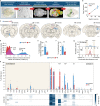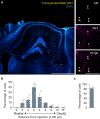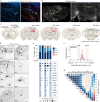Brain-wide reconstruction of inhibitory circuits after traumatic brain injury
- PMID: 35701434
- PMCID: PMC9197933
- DOI: 10.1038/s41467-022-31072-2
Brain-wide reconstruction of inhibitory circuits after traumatic brain injury
Abstract
Despite the fundamental importance of understanding the brain's wiring diagram, our knowledge of how neuronal connectivity is rewired by traumatic brain injury remains remarkably incomplete. Here we use cellular resolution whole-brain imaging to generate brain-wide maps of the input to inhibitory neurons in a mouse model of traumatic brain injury. We find that somatostatin interneurons are converted into hyperconnected hubs in multiple brain regions, with rich local network connections but diminished long-range inputs, even at areas not directly damaged. The loss of long-range input does not correlate with cell loss in distant brain regions. Interneurons transplanted into the injury site receive orthotopic local and long-range input, suggesting the machinery for establishing distant connections remains intact even after a severe injury. Our results uncover a potential strategy to sustain and optimize inhibition after traumatic brain injury that involves spatial reorganization of the direct inputs to inhibitory neurons across the brain.
© 2022. The Author(s).
Conflict of interest statement
The authors declare no competing interests.
Figures








Comment in
-
iDISCO Inferno: Mapping Connectivity Changes Following TBI.Epilepsy Curr. 2023 Jan 18;23(2):127-129. doi: 10.1177/15357597221149263. eCollection 2023 Mar-Apr. Epilepsy Curr. 2023. PMID: 37122404 Free PMC article. No abstract available.
Similar articles
-
Cell Type-Specific Circuit Mapping Reveals the Presynaptic Connectivity of Developing Cortical Circuits.J Neurosci. 2016 Mar 16;36(11):3378-90. doi: 10.1523/JNEUROSCI.0375-15.2016. J Neurosci. 2016. PMID: 26985044 Free PMC article.
-
Brain-Wide Maps of Synaptic Input to Cortical Interneurons.J Neurosci. 2016 Apr 6;36(14):4000-9. doi: 10.1523/JNEUROSCI.3967-15.2016. J Neurosci. 2016. PMID: 27053207 Free PMC article.
-
Brain Injury-Induced Synaptic Reorganization in Hilar Inhibitory Neurons Is Differentially Suppressed by Rapamycin.eNeuro. 2017 Oct 4;4(5):ENEURO.0134-17.2017. doi: 10.1523/ENEURO.0134-17.2017. eCollection 2017 Sep-Oct. eNeuro. 2017. PMID: 29085896 Free PMC article.
-
Selective vulnerability of hippocampal interneurons to graded traumatic brain injury.Neurobiol Dis. 2019 Sep;129:208-216. doi: 10.1016/j.nbd.2018.07.022. Epub 2018 Jul 19. Neurobiol Dis. 2019. PMID: 30031783 Free PMC article. Review.
-
Building thalamic neuronal networks during mouse development.Front Neural Circuits. 2023 Feb 3;17:1098913. doi: 10.3389/fncir.2023.1098913. eCollection 2023. Front Neural Circuits. 2023. PMID: 36817644 Free PMC article. Review.
Cited by
-
Somatic mosaicism and interneuron involvement in mTORopathies.Trends Neurosci. 2025 May;48(5):362-376. doi: 10.1016/j.tins.2025.02.009. Epub 2025 Mar 22. Trends Neurosci. 2025. PMID: 40121168 Review.
-
Viral-mediated increased hippocampal neurogranin modulate synapses at one month in a rat model of controlled cortical impact.Sci Rep. 2024 Nov 22;14(1):28998. doi: 10.1038/s41598-024-77682-2. Sci Rep. 2024. PMID: 39578516 Free PMC article.
-
Establishment and Application of a Novel In Vitro Model of Microglial Activation in Traumatic Brain Injury.J Neurosci. 2023 Jan 11;43(2):319-332. doi: 10.1523/JNEUROSCI.1539-22.2022. Epub 2022 Nov 29. J Neurosci. 2023. PMID: 36446585 Free PMC article.
-
Single-nucleus and spatial signatures of the brainstem in normal brain and mild traumatic brain injury in male mice.Nat Commun. 2025 May 31;16(1):5082. doi: 10.1038/s41467-025-59856-2. Nat Commun. 2025. PMID: 40450008 Free PMC article.
-
Amlexanox Ameliorates Traumatic Brain Injury by Restoring Autophagy-Lysosomal Function via cAMP Signaling Modulation.Int J Biol Sci. 2025 Jul 6;21(10):4467-4484. doi: 10.7150/ijbs.111216. eCollection 2025. Int J Biol Sci. 2025. PMID: 40765831 Free PMC article.
References
Publication types
MeSH terms
Grants and funding
LinkOut - more resources
Full Text Sources
Medical
Molecular Biology Databases

